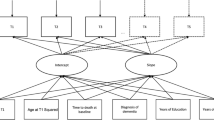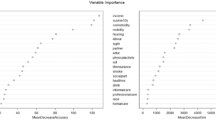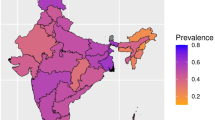Abstract
This paper examines patterns in old-age frailty within a multistate model that characterises the stochastic process of biological ageing. Using aggregate population-level U.S. mortality data, we study differences in frailty by gender and cohort. Our results show that, on average, women tend to be frailer than men at older ages with the male–female divergence growing considerably past age 80. We also find that average frailty levels have fluctuated over time with a distinct peak-and-trough pattern. These cohort trends in frailty and the subsequent dynamic forecasts of frailty among newer cohorts closely mirror how late-life disability has evolved among older Americans in recent decades, underscoring the important connection between frailty conditions and disability among older adults. The implications of these findings on spending for long-term care programmes within the broader health insurance system are discussed.





Similar content being viewed by others
Notes
CBO (2013).
CMS (2014).
Office of the Actuary (2015).
Unlike the stochastic ageing model (or changing frailty model), traditional fixed frailty models assume that frailty is fixed at birth and does not vary with age (see, e.g. Vaupel et al., 1979).
Lin and Liu (2007).
Izsak and Gavrilov (1995).
Human senescence is defined as a gradual deterioration of physiological function with age, which includes an inevitable and irreversible process of loss of viability and increase in vulnerability that renders one more susceptible to death and a number of diseases (Comfort, 1964).
Yashin et al. (1994).
Fong et al. (2015).
Box et al. (2008).
Santos-Eggimann et al. (2009).
References
Bandeen-Roche, K., Seplaki, C.L., Huang, J., Buta, B., Kalyani, R.R., Varadhan, R., Xue, Q.L., Walston, J.D., Kasper, J.D. (2015) ‘Frailty in older adults: A nationally representative profile in the United States’, The Journals of Gerontology Series A: Biological Sciences and Medical Sciences 70(11): 1427–1434.
Box, G., Jenkins, G.M. and Reinsel, G.C. (2008) Time Series Analysis: Forecasting and Control, 4th ed., Hoboken, NJ: Wiley.
Centers for Medicare & Medicaid Services, CMS (2014) National Health Expenditure Data—Historical, from https://www.cms.gov/, accessed 1 August 2015.
Colvez, A. and Blanchet, M. (1981) ‘Disability trends in the United States Population 1966–1976: Analysis of reported causes’, American Journal of Public Health 71(5): 464–471.
Comfort, A. (1964) Ageing: The Biology of Senescence, London: Routledge & Kegan Paul.
Congressional Budget Office, CBO (2013) ‘Rising Demand for Long-term services and Supports for Elderly People’, from www.cbo.gov/publication/44363, accessed 1 August 2015.
Ensrud, K.E., Ewing, S.K., Cawthon, P.M., Fink, H.A., Taylor, B.C., Cauley, J.A., Dam, T.T., Marshall, L.M., Orwoll, E.S., Cummings, S.R. and Osteoporotic Fractures in Men Research Group. (2009) ‘A comparison of frailty indexes for the prediction of falls, disability, fractures, and mortality in older men’, Journal of the American Geriatrics Society 57(3): 492–498.
Fong, J.H., Sherris, M. and Yap, J. (2015) ‘Forecasting Disability: Application of a Frailty Model’, Scandinavian Actuarial Journal, forthcoming. Advanced online publication: 5 October 2015.
Freedman, V.A., Crimmins, E.M., Schoeni, R.F., Spillman, B.C., Aykan, H., Kramarow, E., Land, K., Lubitz, J., Manton, K., Martin, L.G., Shinberg, D. and Waidmann, T. (2004) ‘Resolving inconsistencies in old-age disability trends: Report from a Technical Working Group’, Demography 41(3): 417–441.
Fried, L.P., Tangen, C.M., Walston, J., Newman, A.B., Hirsch, C., Gottdiener, J., Seeman, T., Tracy, R., Kop, W.J., Burke, G., McBurnie, M.A. and Cardiovascular Health Study Collaborative Research Group. (2001) ‘Frailty in older adults: Evidence for a phenotype’, Journal of Gerontology: Medical Sciences 56A(3): M146–M156.
Goggins, W., Woo, J., Sham, A. and Ho, S.C. (2005) ‘Frailty index as a measure of biological age in a Chinese population’, The Journals of Gerontology. Series A, Biological Sciences and Medical Sciences 60(8): 1046–1051.
Hubbard, R.E. and Rockwood, K. (2011) ‘Frailty in older women’, Maturitas 69(3): 203–207.
Izsak, J. and Gavrilov, L.A. (1995) ‘A typical interdisciplinary topic: Questions of the mortality dynamics’, Archives of Gerontology and Geriatrics 20(3): 283–293.
Le Bras, H. (1976) ‘Lois de mortalité et Age Limite’, Population (French Edition) 31(3): 655–692.
Lin, S., Beck, A., Finch, B., Hummer, R. and Master, R. (2012) ‘Trends in US older adult disability: Exploring age, period, and cohort effects’, American Journal of Public Health 102(11): 2157–2163.
Lin, X.S. and Liu, X. (2007) ‘Markov aging process and phase-type law of mortality’, North American Actuarial Journal 11(4): 92–109.
Manton, K.G., Stallard, E. and Corder, L. (1995) ‘Changes in morbidity and chronic disability in the U.S. Elderly Population: Evidence from the 1982, 1984, and 1989 National Long Term Care Surveys’, Journals of Gerontology: Social Sciences 50B(4): S194–S204.
Mitnitski, A., Bao, L., Skoog, I. and Rockwood, K. (2007) ‘A cross-national study of transitions in deficit counts in two birth cohorts: Implications for modeling ageing’, Experimental Gerontology 42(3): 241–246.
Office of the Actuary (2015) ‘2014 Actuarial Report on the Financial Outlook for Medicaid’ from www.medicaid.gov/medicaid-chip-program-information/by-topics/financing-and-reimbursement/downloads/medicaid-actuarial-report-2014.pdf, accessed 1 October 2015.
Rockwood, K., Mitnitski, A., Song, X., Steen, B. and Skoog, I. (2006) ‘Long-term risks of death and institutionalization of elderly people in relation to deficit accumulation at age 70’, Journal of the American Geriatrics Society 54(6): 975–979.
Rockwood, K., Stadnyk, K., MacKnight, C., McDowell, I., Hébert, R. and Hogan, D.B. (1999) ‘A brief clinical instrument to classify frailty in elderly people’, The Lancet 353(9148): 205–206.
Santos-Eggimann, B., Cuenoud, P., Spagnoli, J. and Junod, J. (2009) ‘Prevalence of frailty in middle-aged and older community-dwelling Europeans living in 10 countries’, The Journals of Gerontology 64(6): 675–681.
Seeman, T.E., Merkin, S.S., Crimmins, E.M. and Karlamangla, A.S. (2010) ‘Disability trends among older Americans: National Health and Nutrition Examination Surveys, 1988–1994 and 1999–2004’, American Journal of Public Health 100(1): 100–107.
Vaupel, J.W., Manton, K.G. and Stallard, E. (1979) ‘The impact of heterogeneity in individual frailty on the dynamics of mortality’, Demography 16 (3): 439–454.
Verbrugge, L. (1984) ‘Longer life but worsening health? Trends in health and mortality of middle-aged and older persons’, Milbank Memorial Fund Health and Society 62: 475–519.
Xue, Q. (2011) ‘The frailty syndrome: Definition and natural history’, Clinics in Geriatric Medicine 27(1): 1–15.
Yashin, A.I., Vaupel, J.W. and Iachine, I.A. (1994) ‘A duality in aging: The equivalence of mortality models based on radically different concepts’, Mechanisms of Ageing and Development 74(1): 1–14.
Author information
Authors and Affiliations
Corresponding author
Appendix
Appendix
This Appendix presents the correlations between the fitted model parameters (\(\mu_{0}\), \(\mu\), \(\lambda_{0}\), and \(\lambda\)) in the stochastic ageing model. The matrix of scatter plots in Figure A1, which displays the bivariate correlations among each pair of parameter estimates, shows a reasonable spread of data points. We note that some correlations are weak; for example, the correlation coefficient for \(\lambda_{0}\) and \(\mu\) is only 0.03 for females. The correlation coefficient between \(\lambda_{0}\) and \(\mu_{0}\) is −0.62 for males and −0.64 for females, both which are moderate. The highest bivariate correlation is between \(\lambda\) and \(\mu_{0}\) for males (coefficient of 0.91), although the corresponding value for females is somewhat lower at 0.32. Consistent with Yashin et al. and Fong et al.Footnote 22 we observe a negative correlation between parameter estimates \(\mu\) and \(\lambda\) whereby the correlation coefficients are −0.52 and −0.63 for males and females, respectively. This statistical relationship can be rationalized as follows: in any given frailty state \(i\), a higher mortality hazard (\(\mu\)) implies that individuals are more likely to die which logically results in a lower rate of transition to the next frailty state (\(\lambda\)).
Rights and permissions
About this article
Cite this article
Fong, J. Old-age Frailty Patterns and Implications for Long-term Care Programmes. Geneva Pap Risk Insur Issues Pract 42, 114–128 (2017). https://doi.org/10.1057/s41288-016-0006-3
Received:
Accepted:
Published:
Issue Date:
DOI: https://doi.org/10.1057/s41288-016-0006-3





